Harness the benefits of roses with 3 DIY rose soap recipes. These easy melt and pour soaps are fragranced with 3 luxurious rose essential oil blends and coloured with rose clay or pink mica. Read on to learn how to make lovely rose melt and pour soap in a few simple steps. Plus, a couple quick tips on how to package your handmade soaps for easy gift-giving.
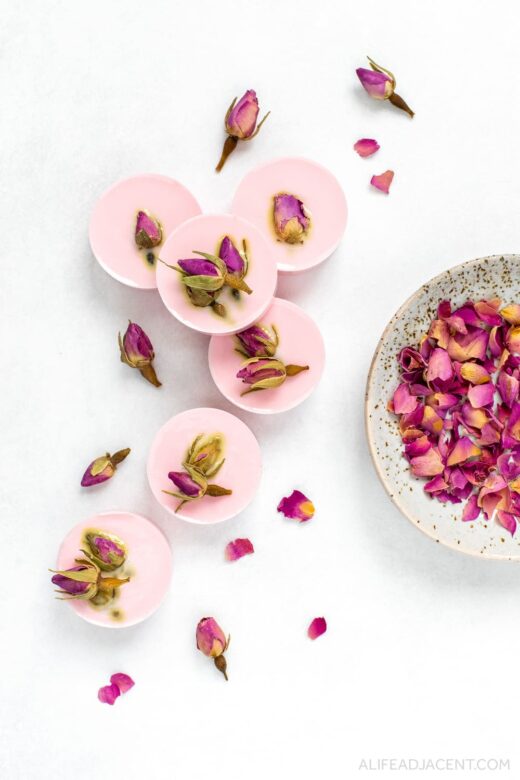
This beginner rose soap recipe is perfect for anyone who enjoys the scent of roses.
But it’s even more perfect for those who may love rose’s fragrance, but not necessarily its high price tag. Because you don’t need to use expensive rose essential oil for this soap recipe.
Rather, this rose soap is scented with rose geranium essential oil, which provides a rose-like fragrance without the extra expense of real rose oil.
It’s also lightly garnished with your choice of rose petals or rose buds, making it a lovely soap for gifting.
The beauty of melt and pour soapmaking is that it’s very simple to master, so this is an ideal rose soap recipe if you’re new to soapmaking. Because if you’ve never used melt and pour soap base before, you’re going to enjoy how easy it is to use and customize.

DIY rose soap made with melt and pour soap
If you’ve spent any time on our blog, you know we rave about melt and pour soap bases because they’re so easy and convenient.
In fact, we’ve shared several melt and pour soap recipes, including a honey almond soap and an original sugar cookie soap recipe.
Melt and pour soap base is also an incredibly easy way to make rose soap because it doesn’t require the hassle of handling lye.
So if you don’t want to work with lye for whatever reason, you won’t need to use it for this recipe. This is because melt and pour soap base is already saponified so that step has been taken care of for you!
But another benefit to melt and pour that can’t be overlooked is that it has a short curing (drying) time. While on the other hand, cold process soapmaking requires weeks long curing times.
There are also a variety of melt and pour soap bases to choose from which makes customization very easy — shea butter, oatmeal, goat’s milk, cocoa butter, and glycerin bases, to name a few.
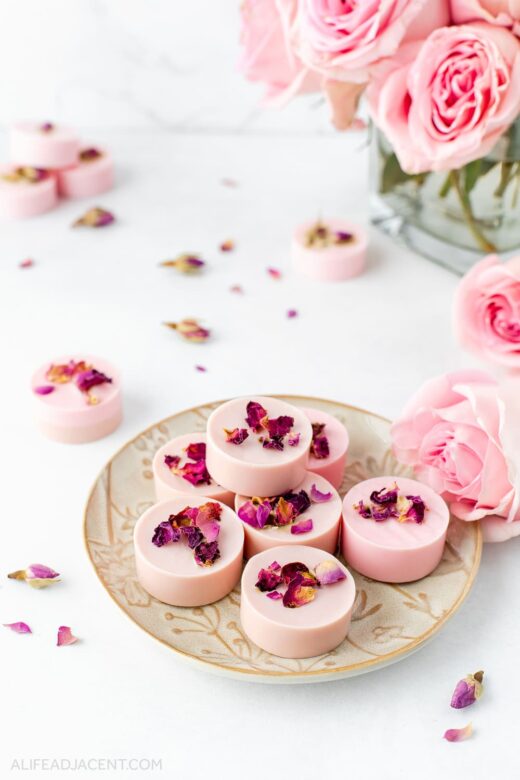
For this rose soap recipe, I choose a nourishing goats milk melt and pour soap base. Goats milk soap has incredible hydrating properties, a wonderfully rich lather, and its lovely white tone is also the perfect backdrop for a beautiful soft pink coloured rose soap.
It was also the ideal base to make these soaps a little more soothing for dry skin and ultra-hydrating for mature skin.
But if you’re vegan, you can substitute the goats milk base for any plain white soap base.
Rose geranium essential oil
I made rose soap with essential oils in 3 different scents: rose vanilla, rose citrus and rose frankincense, and you can read more about each blend below.
Real rose oil’s fragrance is exquisite, but not exactly an economical choice for soap making. Which is why these soaps are scented with rose geranium essential oil.
While not from the same plant family, rose and rose geranium share some similarities. Rose geranium oil has a rose-like fragrance that’s frequently used as a substitute for rose.
Rose geranium is even used to adulterate (dilute) real rose oil – not exactly ethical, but this just illustrates how similar their fragrances are.
Of course, if desired, you have the option of using real rose essential oil in your soap, or a pre-diluted, and more affordable rose otto.
Regardless of which oil you use, any leftover can also be used to make lovely DIY rose bath bombs, rose lotion bars or rose lip balm.
Benefits of rose soap
The main benefit of using essential oils in your homemade soap recipes is their aromatherapeutic properties, as the soothing fragrance of roses has been shown to provide stress-relieving effects1.
By simply smelling fresh roses, rose essential oil, or by using soap with rose petals, you can help calm your nerves and hopefully feel more relaxed after a long or stressful day2.

Luckily, the same benefits apply for less expensive rose geranium essential oil as well, as geranium’s fragrance has been shown to help decrease anxiety and markers of stress3.
Another benefit that can’t be overlooked is that roses, geraniums and their extracts are also touted for their astringent and anti-inflammatory properties, which is why they’re a frequent ingredient in beauty and skincare products.
For more ways to use rose geranium oil, check out our aromatherapy perfume recipes. And if you need to unwind, try these relaxing rose shower steamers.
DIY rose soap ingredients
Making this rose melt and pour soap only requires a few ingredients:
Melt and pour soap base
Of course the main ingredient of any melt and pour soap recipe is the soap base. As mentioned, I used moisturizing goat milk soap base, but you can use any variety of melt and pour you wish.
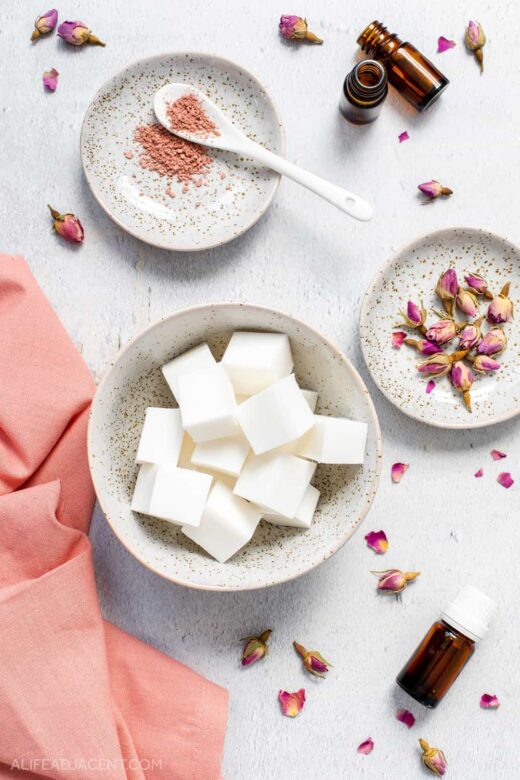
Soap colourant
You can make rose soap with rose clay (pink clay) or pink mica to give it a pale rose colour. I used both: rose clay in the round soap with rose petals, and light pink mica for the other varieties.
You’ll notice that the rose clay soap recipe is slightly more brown toned, while the mica soap is a more cool-toned pastel pink. See below for a photo comparing the two.
- Rose clay: The benefit of rose clay is that it offers a silky texture and oil absorbing benefits. But rose clay is gentle, and any drying qualities are balanced out by the nourishing soap base.
- Rose mica: Mica’s fine particles and shimmery quality also make it an ideal natural soap colourant. We recommend using ethical mica when it’s available, which you can read more about in this post.
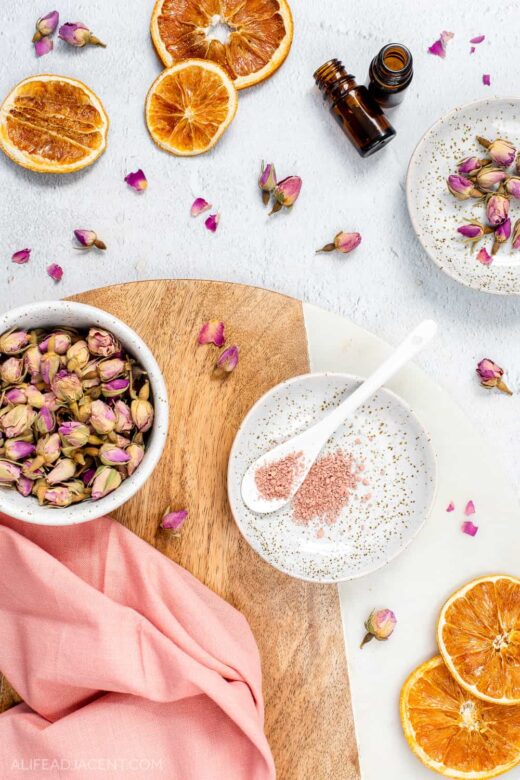
Corn starch
You can also mix a small amount of cornstarch into your soap colorant to make your soap a lighter, more pastel shade of pink.
Rose buds or rose petals
If desired, you can use rosebuds or rose petals to lightly garnish your soaps, which makes them particularly lovely for gift-giving.
Essential oils
To fragrance your rose petal soap, you can choose from 3 rose geranium essential oil blends. See the section below on the exact essential oils used for each variety of rose soap.
All varieties of this soap recipe were scented using essential oils from Simply Earth’s Essential Oil Recipe Box, a monthly subscription box that includes 4 full-size essential oils, 6 recipes, and the supplies to make each one.
For instance, May’s month’s box contained 2 rose soap recipes, rose clay, melt and pour soap base, and a soap mold to make your own rose soap. You can see the full box contents here.

It also included 4 full-size, high quality essential oils: sweet orange, frankincense, oregano, and their unique Tranquility blend which promotes relaxation and calm.
I also used their rose geranium oil in these soap recipes as well, which isn’t in May’s box but can be purchased separately.
If you’re interested, you can use our code ALIFEADJACENTFREE to get a $40 gift card with your first Simply Earth box.
You’ll also receive a free Bonus Box if you subscribe, which contains all sorts of useful goodies to make your own soap and other essential oil DIYs!
You don’t have to use the Simply Earth Box to make these soaps, but it’s very convenient when essentials oils come straight to your doorstep. However, the boxes do sell out fast so you can also purchase the essential oils separately, if you wish.
Tools for making rose soap at home
Aside from your ingredients, you will also need the following tools to make your homemade rose soap:
- Silicone soap molds: I used two different molds for this rose soap recipe: a small rectangular mold for rose soap bars, and a very small circular mold to create a tiny round soap which is intended to be used as a hand soap. Both varieties are perfect for gifts and can also be used as bridal shower favours or for other occasions.
- Heat-proof glass measuring cup with spout: Pyrex measuring cups are very handy for soap making as the spout making pouring much easier.
- Wooden spoon, whisk or silicone spatula: To mix your rose soap ingredients.
- Cutting board: For chopping your melt and pour soap base.
- Soap knife or sharp kitchen knife: For cutting the soap base.
- Spray bottle with alcohol or rubbing alcohol: For popping the tiny bubbles that often form on the top of soap after pouring.
- Small bowl: For mixing soap colourant: your rose clay or mica with the alcohol and corn starch.
- Tray: This is optional, but a tray makes it easier to move your soap after pouring.

Rose soap essential oil blends
Vanilla Rose
50 drops (1/2 tsp) rose geranium essential oil
25 drops (1/4 tsp) vanilla oleoresin
A classic favourite that creates a lovely rose vanilla soap recipe. This essential oil blend is both sweet and floral, and the warm, delicious scent of vanilla is a wonderful compliment to the rosy geranium oil.
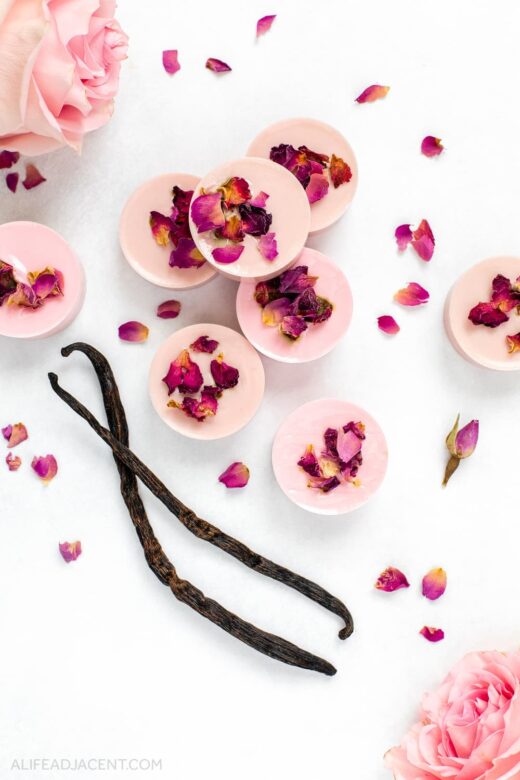
Citrus Rose
50 drops (1/2 tsp) rose geranium essential oil
25 drops (1/4 tsp) sweet orange essential oil
A lovely, uplifting and invigorating citrus blend that is both tangy and floral. A citrus rose soap is the perfect soap for use in the morning time due to it’s energizing scent. If you prefer you can also swap the sweet orange for pink grapefruit essential oil and create a grapefruit rose scented soap.

Rose Frankincense
50 drops (1/2 tsp) rose geranium essential oil
13 drops frankincense essential oil
12 drops Tranquility essential oil blend
Simply Earth’s Tranquility blend is a calming essential oil blend that alleviates anxiousness and promotes feelings of contentment and ease. It contains a sweet-smelling blend of ylang-ylang, lemon, sweet orange and a hint of patchouli to encourage an overall sense of well-being.

Additionally, frankincense essential oil is known to have soothing and rejuvenating properties, making this a lovely rose soap recipe for eczema prone or sensitive skin4.
Although, always remember never to apply essential oils directly to skin as they must be diluted in a carrier oil or in a skincare product such as soap.
DIY Rose Soap Recipe
1/2 lb goats milk soap base or white soap base for vegans
1 tsp rose clay or 1/8 tsp of pink mica (see notes)
1 1/4 tsp cornstarch
1 tbsp high-proof alcohol
Rose essential oil blend of your choice (blends above)
Handful of rose buds or rose petals
Small bottle of alcohol in mini spray bottle
How to make rose melt and pour soap
- Prepare your supplies and work space by washing everything with soap and water. You can also sanitize your work area and tools with a few spritzes of alcohol.
- Mix the rose clay (or pink mica), alcohol and cornstarch in a small bowl. Set aside.
- Chop your soap base into approximately 1 inch cubes. Place the soap cubes into a measuring cup with a spout and heat in the microwave in 30 second bursts. Still gently in between each heating. You may need to heat the soap base 3-4 times until it’s liquified, but don’t overheat. You should also make the bursts slightly shorter as the soap melts.
Tip: Alternatively, you can use the double boiler method which is essentially a heat-safe bowl over a saucepan of bowling water. The steam will melt the soap, without the worry of burning the soap. - Once the soap base has melted, add the rose clay or pink mica mixture slowly. Stir gently.
- Allow the soap to cool for a couple minutes before adding your essential oils, as adding them too soon could cause their scent to dissipate. Stir lightly once more.
- Now, you’re ready to pour. Carefully pour the soap mixture into the molds.
- Next, place the rose petals or buds on top of your soaps. You can add a simple rose bud or two. Or you can sprinkle the petals on randomly to create a unique pattern.
Tip: Place the petals on the soap before it begins to harden or the petals won’t stick very well. Also, try to anchor just the edges or tips of the petals in the soap. Immersing the petals in the soap too much increases the chances of the soap turning brown. I find that by just anchoring the edges of the petals, this helps control the browning of the soap. - Allow your rose soaps to cool for at approximately 20 minutes. You don’t want to move them until they’re set or you will disturb the petals. Then, move your soaps to a spot that’s out of the way so they won’t get bumped. Be sure the spot is away from direct sunlight as well. Allow them to set for another 2 hours, or overnight, if preferred.
- Once hardened, carefully unmold each soap. Allow to cure for approximately 2-3 days to fully dry out. Your rose soaps are then ready to use or gift.

Tips for making homemade rose soap
- This recipe uses half a pound (8 oz) of melt and pour soap base, which yields approximately 4 small 2 oz guest-sized rectangular soap bars, or approximately 6-7 tiny hand soaps when using the small round soap mold. If you use a different silicone mold, or double the recipe, your amounts will vary.
- You can use more or less soap colourant depending on your colour preference.
- Place your silicone soap mold on a cookie sheet or tray which will make it easier to move later.
- Always stir your soap gently, as vigorous stirring can create bubbles in your soap.
- Have a small spray bottle of high-proof vodka or rubbing alcohol in a small spray bottle handy so that if bubbles appear on top of your soap after pouring, you can spritz the top of your soaps. Alcohol pops soap bubbles.

How to keep rose petal soap from turning brown?
Place the flowers on top of your rose petal soap rather than on the bottom of your molds. If you place the rose petals in the soap, they will turn brown over time. The petals will also migrate.
By putting them on top, this gives you more control over their placement and they’re also less likely to turn brown. Although, there will be some browning when they’re placed on top, but I find that it’s not as noticeable as when the rose petals are mixed throughout the soap.
You can also use tweezers to place the petals and to make sure only the edge of the petals are suspended in the soap. I find that when only a portion of the petal is attached to the soap base, this can prevent the soaps from browning too much due to the rose petals.
Do I need to store this handmade soap in plastic wrap
Yes, it’s a good idea to wrap your soap in regular plastic wrap as it prevents it from sweating and forming glycerin dew. You should also wrap your DIY soaps in plastic wrap before wrapping them in paper, or before putting them in another container.
How to prevent glycerin dew in rose soap
Melt and pour soap is prone to sweating and beading which is also called glycerin dew. The dew occurs due to melt and pour soap’s high glycerin content.
Glycerin is a humectant and is added to melt and pour soap during the manufacturing process. Since humectants draw water from the surrounding environment, your handmade soaps can sweat or bead when exposed to air, especially in hot or humid climates. It’s also why melt and pour soap can be so wonderfully hydrating for dry skin.
But to combat the formation of glycerin dew, be sure to dry your soaps thoroughly before tightly wrapping them in plastic wrap.
While melt and pour soap doesn’t necessitate the long curing times associated with traditional soap making, we still opt to let our melt and pour soap dry for approximately 2-3 days before wrapping them.
How to wrap homemade soap for gifts
Rose petal melt and pour soap is an easy and beautiful handmade gift idea for any occasion. Wrap each piece individually in approximately 5×7 pieces of plastic wrap. Fold the sides over both ends and secure tightly.
You can also cut 5×7 pieces of colourful paper or recycled brown paper to wrap your soaps. Simply fold the paper like you would if you were wrapping a present, then add a pretty ribbon or some natural twine.
But if you want a more professional looking wrapped soap, this video has some great tips on how to wrap soap to sell!
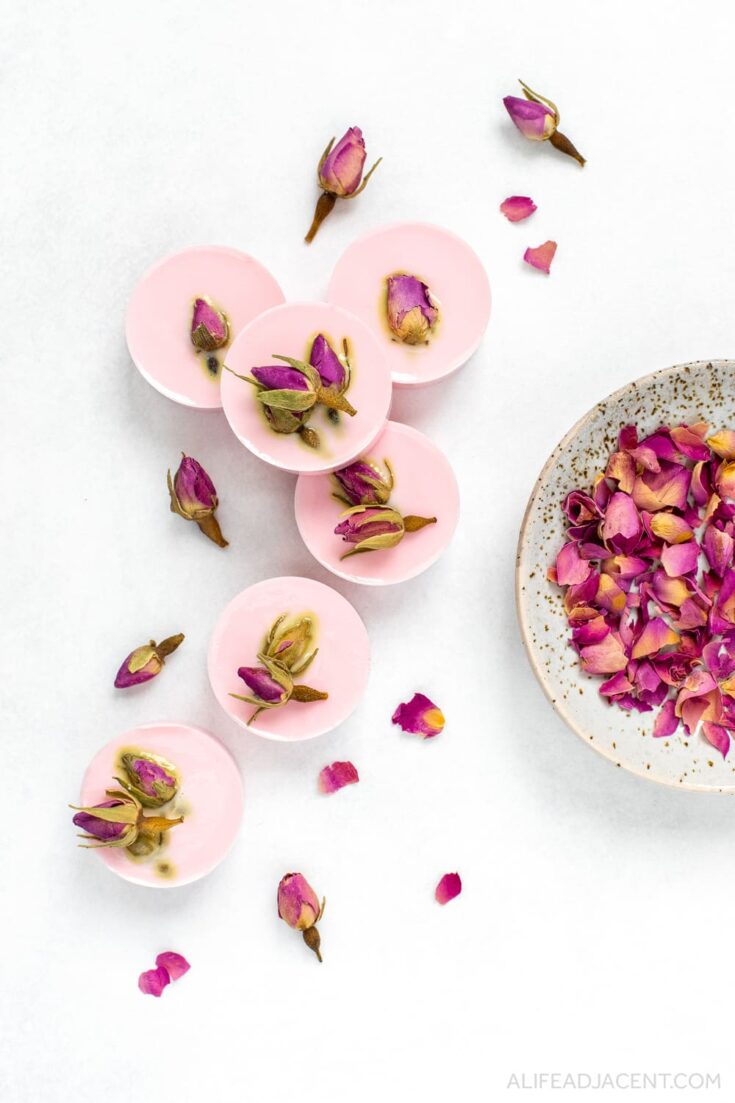
DIY Rose Soap – 3 Melt and Pour Soap Recipes
Learn how to make beautiful DIY rose soap with this easy rose melt and pour soap recipe! Choose between 3 essential oil blends for your soap: vanilla rose, citrus rose, and rose frankincense. Each rose soap recipe is made with rose petals, rose clay and essential oils.
Materials
Vanilla Rose Soap
- 1/2 lb goats milk soap base or other white soap base
- 1 tsp rose clay or 1/8 tsp of pink mica
- 1 1/4 tsp cornstarch
- 1 tbsp high-proof alcohol
- 50 drops (1/2 tsp) rose geranium essential oil
- 25 drops (1/4 tsp) vanilla oleoresin
- Handful of rose buds or rose petals to garnish
Citrus Rose Soap
- 1/2 lb goats milk soap base or other white soap base
- 1 tsp rose clay or 1/8 tsp of pink mica
- 1 1/4 tsp cornstarch
- 1 tbsp high-proof alcohol
- 50 drops (1/2 tsp) rose geranium essential oil
- 25 drops (1/4 tsp) sweet orange essential oil
- Handful of rose buds or rose petals to garnish
Rose Frankincense Soap
- 1/2 lb goats milk soap base or other white soap base
- 1 tsp rose clay or 1/8 tsp of pink mica
- 1 1/4 tsp cornstarch
- 1 tbsp high-proof alcohol
- 50 drops (1/2 tsp) rose geranium essential oil
- 13 drops frankincense essential oil
- 12 drops Tranquility essential oil blend
- Handful of rose buds or rose petals to garnish
Tools
- Small bottle of alcohol in mini spray bottle
- Silicone soap mold (bar mold or <a round mold)
- Heat-proof glass measuring cup with spout (like Pyrex)
- Wooden spoon, whisk or silicone spatula
Instructions
- Prepare your supplies and work space by washing everything with soap and water. You can also sanitize your work area and tools with a few spritzes of alcohol.
- Mix the rose clay (or pink mica), alcohol and cornstarch in a small bowl. Set aside.
- Chop your soap base into approximately 1 inch cubes. Place the soap cubes into a measuring cup with a spout and heat in the microwave in 30 second bursts. Still gently in between each heating. You may need to heat the soap base 3-4 times until it’s liquified, but don't overheat. You should also make the bursts slightly shorter as the soap melts.
Tip: Alternatively, you can use the double boiler method which is essentially a heat-safe bowl over a saucepan of bowling water. The steam will melt the soap, without the worry of burning the soap. - Once the soap base has melted, add the rose clay or pink mica mixture slowly. Stir gently.
- Allow the soap to cool for a couple minutes before adding your essential oils, as adding them too soon could cause their scent to dissipate. Stir lightly once more.
- Now, you’re ready to pour. Carefully pour the soap mixture into the molds.
- Next, place the rose petals or buds on top of your soaps. You can add a simple rose bud or two. Or you can sprinkle the petals on randomly to create a unique pattern.
Tip: Place the petals on the soap before it begins to harden or the petals won’t stick very well. Also, try to anchor just the edges or tips of the petals in the soap. Immersing the petals in the soap too much increases the chances of the soap turning brown. I find that by just anchoring the edges of the petals, this helps control the browning of the soap. - Allow your rose soaps to cool for at approximately 20 minutes. You don’t want to move them until they're set or you will disturb the petals. Then, move your soaps to a spot that’s out of the way so they won’t get bumped. Be sure the spot is away from direct sunlight as well. Allow them to set for another 2 hours, or overnight, if preferred.
- Once hardened, carefully unmold each soap. Allow to cure for approximately 2-3 days to fully dry out. Your rose soaps are then ready to use or gift.
Notes
Tips for making DIY rose soap
- This recipe uses half a pound (8 oz) of melt and pour soap base, which yields approximately 4 small 2 oz guest-sized rectangular soap bars, or approximately 6-7 tiny hand soaps when using the small round soap mold. If you use a different silicone mold, or double the recipe, your amounts will vary.
- You can use more or less soap colourant depending on your colour preference.
- Place your silicone soap mold on a cookie sheet or tray which will make it easier to move later.
- Always stir your soap gently, as vigorous stirring can create bubbles in your soap.
- Have a small bottle of high-proof vodka or rubbing alcohol in a small spray bottle handy so that if bubbles appear on top of your soap after pouring, you can spritz the top of your soaps. Alcohol pops soap bubbles.
Recommended Products
As an Amazon Associate and member of other affiliate programs, we earn from qualifying purchases.
More homemade soap recipes
If you enjoyed this rose soap, you might also enjoy these other recipes:
For more ways to use rose petals:
For more DIY soap and bath and body recipes, follow us on Pinterest, Instagram, YouTube, Facebook, TikTok, and Twitter.
Pin it for later
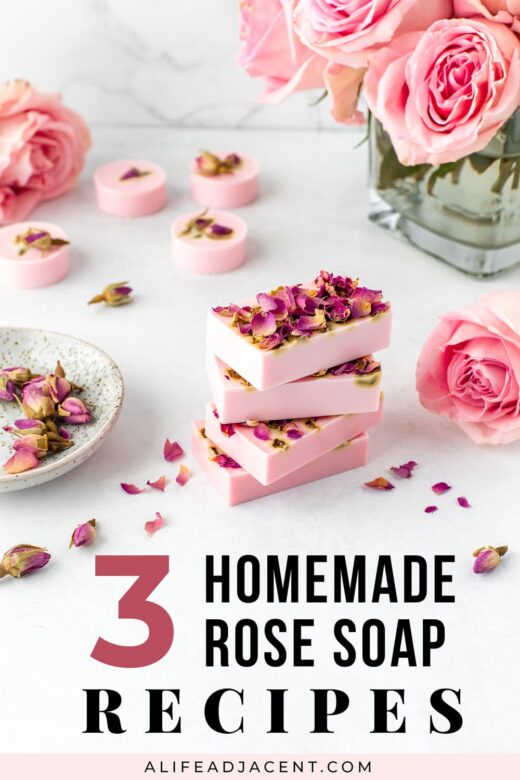
- Mohebitabar, Safieh et al. “Therapeutic efficacy of rose oil: A comprehensive review of clinical evidence.” Avicenna journal of phytomedicine vol. 7,3 (2017): 206-213.
- Setzer, William N. “Essential oils and anxiolytic aromatherapy.” Natural product communications vol. 4,9 (2009): 1305-16.
- Rashidi Fakari, Fahimeh et al. “Effect of Inhalation of Aroma of Geranium Essence on Anxiety and Physiological Parameters during First Stage of Labor in Nulliparous Women: a Randomized Clinical Trial.” Journal of caring sciences vol. 4,2 135-41. 1 Jun. 2015, doi:10.15171/jcs.2015.014
- Orchard, Ané, and Sandy van Vuuren. “Commercial Essential Oils as Potential Antimicrobials to Treat Skin Diseases.” Evidence-based complementary and alternative medicine : eCAM vol. 2017 (2017): 4517971. doi:10.1155/2017/4517971







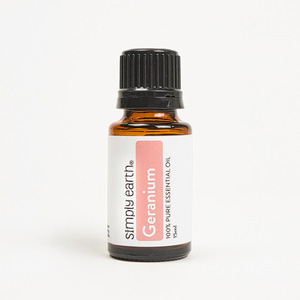


Iris
Sunday 31st of December 2023
What is the purpose of the cornflour added to the rose soap? Is it necessary or can it be left out? Thanks
Iris
Wednesday 3rd of January 2024
@Kyla, thanks for your thoughts. Could I also add white mica or titanium dioxide to the pink to lighten the colour instead of adding cornstarch. Thanks again
Kyla
Tuesday 2nd of January 2024
Hi Iris, the corn starch is only for aesthetic purposes. If you mix it with your rose clay, mica, or another soap colorant, it turns your soap a lighter, more pastel shade of pink. It's not necessary, so you can omit it if you prefer without affecting your final product. Hope this helps!